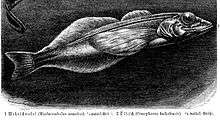Comephorus
| Comephorus | |
|---|---|
 | |
| Scientific classification | |
| Kingdom: | Animalia |
| Phylum: | Chordata |
| Class: | Actinopterygii |
| Order: | Scorpaeniformes |
| Superfamily: | Cottoidea |
| Family: | Comephoridae Günther, 1861 |
| Genus: | Comephorus Lacepède, 1800 |
Comephorus, known as the golomyankas or Baikal oilfish, are a genus comprising two species of peculiar, sculpin fishes endemic to Lake Baikal in Russia. Comephorus is the only genus in the family Comephoridae. Golomyankas are pelagic fishes which make the main food source of the Baikal seal.
Description
Comephorus have translucent bodies with no scales[1] and can reach up to 21 cm (8.3 in) in length.[2] They have long pectoral fins, and although pelvic bones are present, they lack pelvic fins. They have a strong lateral line. The lateral line system on the head consists of large cavities linked by narrow, bony bridges with small external pores. High lipid content and porous bones result in an almost neutral buoyancy[3] and lack of swim bladder allows the fish to tolerate varying pressure extremes as they move through the water column. Over a third of the body weight (38.9%) of C. baicalensis is oil, but C. dybowski contains far less (4.7%).[4] Some of their adaptions resemble those seen in deep sea fish.[3] The common name golomyanka literally means 'naked.
Species
There are currently two recognized species in this genus:[2]
- Comephorus baikalensis (Pallas, 1776) (Big Baikal oilfish)
- Comephorus dybowskii (Korotneff, 1904) (Little Baikal oilfish)
Biology and ecology
They are the principal ecological competitor to the omul, and represent a primary food source for the Baikal seal. They are easily identifiable, and are large enough to be easily seen. Golomyankas are unusual for occurring pelagically throughout the entire water column of Lake Baikal, ranging from depths in excess of 1 km (0.62 mi) to near the surface, but they primarily occur below 100 m (330 ft).[5][6] They move without much regard for changes in pressure, although they can exist only in cold temperatures, preferring water up to 5 °C (41 °F) and dying at 10 °C (50 °F).[1][7] They are considered the world's most abyssal freshwater fish. They are also known for decomposing in sunlight, leaving behind fatty oil and bones.[7]
The biomass of the golomyanka population is estimated at about 150 thousand tons, making it the most populous fish in Lake Baikal.[1][7] Their juveniles are also the most abundant pelagic fish larvae in the lake.[8] Shoaling behavior is not known for this species, and the females do not lay eggs; rather, they are viviparous, producing a swarm of 2000-3000 larvae.[7] Most females die afterwards.[1] Golomyanka can reach an age of up to 6 years.[1]
They are sluggish fish,[9] and primarily feed on the planktonic Epischura baikalensis, the amphipod crustacean Macrohectopus branickii and larvae of sculpins.[10]
Relationship to humans
Due to their solitary lives, golomyankas are not harvested commercially, although their fats and oils were used in lamps and as traditional medicine by native Siberians when storms tossed the fish up on shore.[7] They are valued primarily as the principal food source for the Baikal seal nerpa, which are harvested commercially. They are so numerous and spawn so rapidly that they represent the largest concentration of fish biomass within the entire lake, and would seriously unbalance the ecosystem of Lake Baikal if not constantly fed upon by predators.
See also
References
- 1 2 3 4 5 Animals and plants of Lake Baikal from Irkutsk State University, accessed May 5, 2006
- 1 2 Froese, Rainer, and Daniel Pauly, eds. (2012). Species of Comephorus in FishBase. December 2012 version.
- 1 2 Sideleva, V.G. (1996). Comparative character of the deep-water and inshore cottoid fishes endemic to Lake Baikal. Journal of Fish Biology 49(sA): 192–206.
- ↑ Lipids and fatty acids of two pelagic cottoid fishes (Comephorus spp.) endemic to Lake Baikal, T.A. Kozlovaa and S.V. Khotimchenko, accessed July 31, 2010
- ↑ Froese, Rainer and Pauly, Daniel, eds. (2016). "Comephorus baikalensis" in FishBase. September 2016 version.
- ↑ Froese, Rainer and Pauly, Daniel, eds. (2016). "Comephorus dybowskii" in FishBase. September 2016 version.
- 1 2 3 4 5 Ichthyofauna of Lake Baikal from Baikal Web World, accessed May 5, 2006 (with a photo of the golomyanka).
- ↑ Dzyuba, E.V. (2006). Two coexisting species of Baikal golomyankas, Comephorus baicalensis and C. dybowski: seasonal dynamics of juveniles and their feeding. Hydrobiologia 568, Supplement 1: 111–114.
- ↑ Jakubowski, Tugarina, and Żuwała (2003). Pectoral fin development in the Baikalian viviparous golomyankas (Comephoridae; Cottoidei), with a remark on eggs and embryos of Comephorus baicalensis (Pallas). J.Anat. 203(3): 317-322.
- ↑ Miyasaka, Dzyuba, Genkai-Kato and Wada (2006). Feeding ecology of two planktonic sculpins, Comephorus baicalensis and Comephorus dybowskii (Comephoridae), in Lake Baikal. Ichthyological Research 53(4): 419-422.
- Lake Baikal FAQ Irkutsk State University Lake Baikal FAQ, accessed May 5, 2006